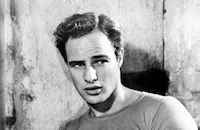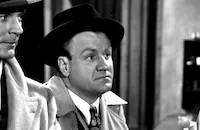The Tennessee Williams Film Collection -- an eight-disc DVD set containing the acclaimed
film adaptations of one of America's greatest playwrights - debuts April 11 from Warner Home
Video. The collection features the long-awaited DVD debuts of
Sweet Bird of Youth,
Night of the Iguana,
Baby Doll and The Roman Spring of Mrs. Stone along with a
newly remastered two-disc Special Edition of
A Streetcar Named Desire and single disc
Deluxe Edition of
Cat on a Hot Tin Roof. Also included is a bonus disc, the rarely seen
feature-length documentary,
Tennessee Williams' South.
Bonus materials in this collection include new making-of documentaries for each film, plus
expert commentaries, never before seen outtakes, rare screen tests with Brando, Rip Torn and
Geraldine Page, a radio broadcast with Brando from 1947 and vintage featurettes. Exclusive to
the collection is a special bonus disc,
Tennessee Williams' South, a feature-length
vintage documentary that includes remarkable interviews with Williams in and around New
Orleans, plus great scenes from Williams' plays especially filmed for this documentary,
including rare footage of Jessica Tandy as Blanche (the role she created in
A Streetcar
Named Desire) and Maureen Stapleton as Amanda in
The Glass Menagerie.
Williams -- from whose pen came stunning unforgettable characters, powerful portraits of the
human condition and an incredible vision of life in the South -- stands with Eugene O'Neill and
Arthur Miller as one of the three quintessentially eminent American playwrights.
Thomas Lanier Williams was born in Columbus, Mississippi, on March 26, 1911 and his southern
upbringing was reflected in the subjects, often based on family members, that he chose to write
about. He published his first short story at the age of sixteen and his first great Broadway
success was
The Glass Menagerie, starring Laurette Taylor that won the New York Drama
Critics' Circle award in 1945 as the best play of the season.
Williams himself often commented on the violence in his own work, which to him seemed part of
the human condition; he was conscious, also, of the violence in his plays. Critics who attacked
the "excesses" of Williams' work often were making thinly veiled assaults on his sexuality.
Homosexuality was not discussed openly at that time but in Williams' plays the themes of desire
and isolation show, among other things, the influence of having grown up gay in a homophobic
world.
A Streetcar Named Desire
A Streetcar Named Desire: 2-Disc Special Edition is a celebration of what is, perhaps,
Williams' greatest masterpiece. This edition features three minutes of footage that was deleted
from the final release version ( and thought lost until its rediscovery in the early 1990s)
that underscores, among other things, the sexual tension between Blanche DuBois (Vivien Leigh)
and Stanley Kowalski (Marlon Brando), and Stella Kowalski's (Kim Hunter) passion for husband
Stanley. The Legion of Decency required these scenes be cut in order for the film to be
released.
A Streetcar Named Desire depicts a culture clash between Blanche DuBois (Vivien Leigh),
a pretentious, fading relic of the Old South, and Stanley Kowalski (Marlon Brando), a rising
member of the industrial, inner-city immigrant class. Blanche is a Southern belle whose
pretensions to virtue and culture only thinly mask her nymphomania and alcoholism. Arriving at
the house of her sister Stella Kowalski (Kim Hunter), Stella fears Blanche's arrival will
upset the balance of her relationship with her husband Stanley, a primal, rough-hewn, brutish
and sensual force of nature. He dominates Stella in every way, and she tolerates his offensive
crudeness and lack of gentility largely because of her sexual need for him. Stanley's friend
and Blanche's would-be suitor Mitch (Karl Malden) is similarly trampled along Blanche and
Stanley's collision course. Their final, inevitable confrontation results in Blanche's mental
annihilation.
The film won Academy Awards for Best Actor in a Supporting Role (Karl Malden), Best Actress in
a Leading Role (Vivien Leigh) , Best Actress in a Supporting Role (Kim Hunter), and Best Art
Direction -- Set Decoration, Black-and-White. It was also nominated for Best Actor in a Leading
Role (Marlon Brando), Best Cinematography, Black-and-White, Best Costume Design,
Black-and-White, Best Director, Best Music, Scoring of a Dramatic or Comedy Picture, Best
Picture, Best Sound Recording and Best Writing, Screenplay. In 1999 the film was selected by
the United States Library of Congress for preservation in the National Film Registry.
Special Features Disc One:
- Commentary by Karl Malden and film historian Rudy Behlmer
- Elia Kazan movie trailer gallery
- Subtitles: English, Francais & Espanol (feature film only)
Special Features Disc Two:
- Movie and audio outtakes
- Marlon Brando screen test
- Elia Kazan: A Director's Journey documentary
- 5 new insightful documentaries:
o A Streetcar on Broadway
o A Streetcar in Hollywood
o Desire and Censorship
o North and the South
o An Actor Named Brando
Cat on a Hot Tin Roof: REMASTERED DELUXE EDITION
The raw emotions and crackling dialogue of Tennessee Williams' 1955 Pulitzer Prize play rumble
like a thunderstorm in this film version whose fiery performances and grown-up themes made it
one of 1958's top box-office hits.
Paul Newman earned his first Oscar® nomination as troubled ex-sports hero Brick. In a
performance that marked a transition to richer adult roles, Elizabeth Taylor snagged her
second. The film was nominated for six Academy Awards including Best Picture. Also starring
Burl Ives (repeating his Broadway triumph as mendacity-loathing Big Daddy), Judith Anderson and
Jack Carson,
Cat on a Hot Tin Roof sizzles.
Cat on a Hot Tin Roof is the story of a Southern family in crisis, focusing on the
turbulent relationship between Maggie the Cat (Elizabeth Taylor) and Brick (Paul Newman), and
their interaction with Brick's family over the course of a weekend gathering at the family
estate. Brick, an aging football hero, has neglected his wife and further infuriates her by
ignoring his brother's attempts to gain control of the family fortune. Although Big Daddy (Burl
Ives) has cancer and will not celebrate another birthday, his doctors and his family have
conspired to keep this information from him and his wife. His relatives are in attendance and
attempt to present themselves in the best possible light, hoping to receive the definitive
share of Big Daddy's enormous wealth.
Oscar® nominations were for Best Picture, Best Screenplay, Best Actor (Newman); Best
Actress (Taylor), Best Director (Richard Brooks) and Best Cinematography.
Special Features:
- Commentary by biographer Donald Spoto, author of The Kindness of Strangers: The Life of
Tennessee Williams
- New featurette
Cat on a Hot Tin Roof: Somebody Up There Likes Him
- Theatrical trailer
- Languages: English & Francais
- Subtitles: English, Francais & Espanol (feature film only)
Sweet Bird of Youth
Paul Newman, Geraldine Page, Rip Torn, Madeleine Sherwood and Ed Begley recreated their stage
roles in this bravura film version which featured Shirley Knight. Begley won Best Supporting
Oscar® and Page and Knight were nominated.
Sex, money, hypocrisy, financial and emotional blackmail are familiar elements in Williams'
literary realm and combine powerfully in
Sweet Bird of Youth as Chance (Newman) battles
his private demons in a desperate bid to redeem his wasted life and recapture his lost sweet
bird of youth.
Handsome Chance Wayne (Newman) never found the Hollywood stardom he craved, but he's always
been a star with the ladies. Now, back in his sleepy, sweaty Gulf Coast hometown, he's involved
with two of them: a washed-up, drug-and-vodka-addled movie queen. And the girl he left
behind…and in trouble.
Special Features:
- New featurette
Sweet Bird of Youth: Broken Dreams and Damaged People
- Never-before-seen Geraldine Page and Rip Torn screen test
- Theatrical trailer
- Languages: English & Francais
- Subtitles: English, Francais & Espanol (feature film only)
Night of the Iguana
With an outstanding cast headed by Richard Burton, Ava Gardner and Deborah Kerr, direction by
legendary John Huston and a steamy screenplay,
Night of the Iguana pulses with
conflicting passions and a surprising edge of knowing humor. Winner of one Academy Award and
nominated for three more, the film explores the dark night of one man's soul - and illuminates
the difference between dreams and the bittersweet surrender to reality.
In a remote Mexican seacoast town, a defrocked Episcopal priest (Richard Burton), ruined by
alcoholism and insanity, struggles to pull his shattered life together. And the three women in
his life - an earthy hotel owner (Ava Gardner), an ethereal artist (Deborah Kerr) and a
hot-eyed, willful teenager (Sue Lyons) - can help save him. Or destroy him.
Shot just south of Puerto Vallarta, Mexico, the tension-filled shoot put that small city on the
map. Due in no small part to the presence of non-cast member Elizabeth Taylor, the shooting of
the film during 1963 attracted large numbers of paparazzi, made international headlines, and in
turn made Puerto Vallarta world-famous.
Special Features:
- Commentary by John Huston
- New featurette The
Night of the Iguana: Dangerous Creatures
- Vintage featurette On the Trail of the Iguana
- 1964 premiere highlights
- Theatrical trailers
- Languages: English & Francais
- Subtitles: English, Francais & Espanol (feature film only)
Baby Doll
With
Baby Doll, as with
A Streetcar Named Desire, director Elia Kazan and writer
Tennessee Williams broke new ground in depicting sexual situations - incorporating themes of
lust, sexual repression, seduction, and the corruption of the human soul.
Time magazine called the film "just possibly the dirtiest American-made motion picture that has
ever been legally exhibited." The film caused a sensation in 1956, also earning condemnation by
the then-powerful Legion of Decency and causing Cardinal Spellman to denounce Doll from his
pulpit.
Baby Doll earned laurels too: four Academy Award nominations, Golden Globe Awards for
Baker and Kazan and a British Academy Award for Wallace. Watch this funny, steamy classic that,
as Leonard Martin's Movie Guide proclaims, "still sizzles."
The film centers around cotton-mill owner Archie (Karl Malden) who's going through tough times
but at least has his luscious, child-bride (Carroll Baker) with whom he'll be allowed to
consummate when she's 20. Rival Silva Vaccaro (Eli Wallach) thinks Archie may have set fire to
his mill and takes an erotic form of Sicilian vengeance.
Special Features:
- New featurette
Baby Doll: See No Evil
-
Baby Doll trailer gallery
- Subtitles: English, Francais & Espanol (feature film only)
The Roman Spring of Mrs. Stone
Widow Karen Stone is wealthy and beautiful. Her acting successes are a memory. She lives alone
in a luxury apartment overlooking the Roman steps where romantic liaisons take place. And
waits. She soon starts an affair with the young and expensive Paolo.
Vivien Leigh and Warren Beatty are lady and lover in this tender adaptation of a Tennessee
Williams novella directed by Broadway veteran Jose Quintero. Leigh won her second Oscar®
for Williams'
A Streetcar Named Desire; their reteaming creates a similar spell - at
once romantic, sinister and nearly explosive. Adding spice to the combustion of the two leads
are Best Supporting Actress Oscar® nominee Lotte Lenya as a Contessa who "arranges”
romances in which she has a financial stake and Coral Browne as Karen's savvy best friend.
Special Features:
- New featurette The Roman Spring of Mrs. Stone: I Can't Imagine Tomorrow
- Theatrical trailer
- Languages: English & Francais
- Subtitles: English, Francais & Espanol (feature film only)








































